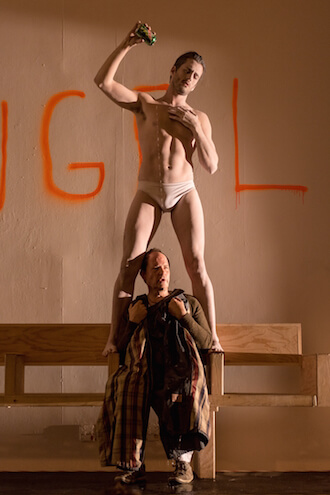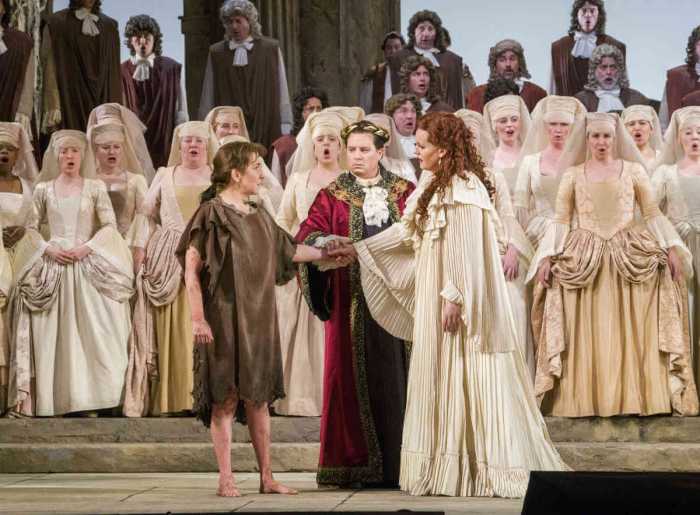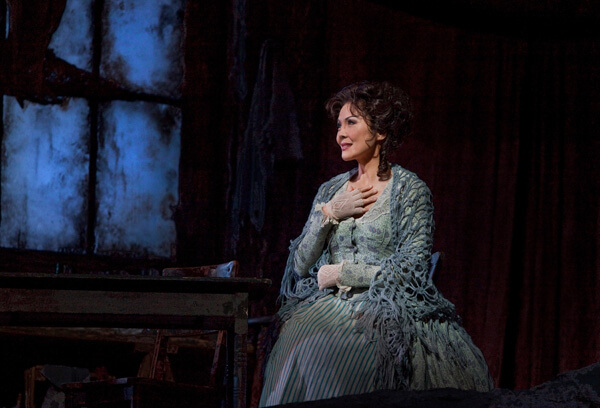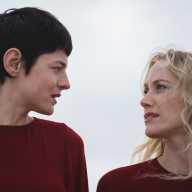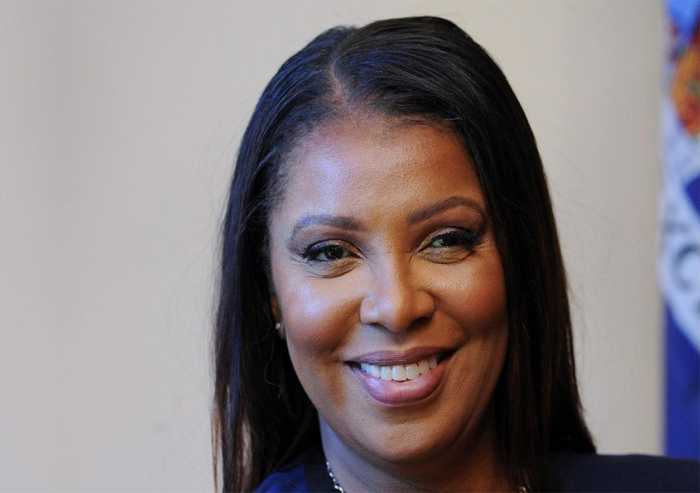Hadleigh Adams and Drew Minter in R. B. Schlather’s production of “Orlando” at the Whitebox Lab. | IAN DOUGLAS
BY DAVID SHENGOLD | Stephen Wadsworth directed a pleasing “Nozze di Figaro” at Juilliard, with his trademark visual taste and attention to detail. Charlie Corcoran’s very basic sets made sense — for once, hurrah, Act IV actually portrayed a garden — and Camille Assaf’s costumes were gorgeous and flattering. Wadsworth illuminated every exchange, also making a “thing” of introducing characters — the Countess, Antonio, Barbarina, and Curzio — onstage before da Ponte’s libretto does. No harm done, and in some cases it explained further developments — though Mozart’s having the Countess show up to introduce Act II allows him to effect a sea change in the score’s tone from that of the rather heartless first act. Two Bad Television touches — Susanna stomping on Basilio’s foot, and Figaro and Susanna pelvis bumping in Act IV’s mock seduction — misfired in an otherwise well-integrated conception.
Ying Fang’s lovely pearly soprano and manner have already elevated her to incipient stardom; her Susanna sounded gorgeous, and greater verbal point will come with experience. Heard April 26, Thesele Kemane’s Figaro had easy, ringing high notes, but for three acts sounded too soft-grained in mid-range and made too little of the text. Alexandra Razskazoff (Countess) has a bright sound evoking the Puccini/ Strauss soundworld more than Mozart. Occasionally sharp, she proved very interesting and certainly projected youthful panache. Takaoki Onishi (Count) looked and moved very well, displaying elegant legato and polished phrasing.
Virginie Verrez’s fine mezzo has too much timbral static for Cherubino, though she acted well. Samantha Hankey made Marcellina anything but matronly and unappealing; her lovely singing was among the afternoon’s highlights. Miles Mykkanen (Basilio) fielded an attractive, substantial tenor; he and Wadsworth managed to make the tutor recognizably gay without cringe-worthy minstrelsy. Liv Redpath (Barbarina) displayed a really exquisite voice, with an immediately recognizable personal timbre.
Handel and Mozart around town
The Juilliard players are first-rate, but some very audible mistakes crept in. Gary Thor Wedow’s leadership was earnest but both a bit bland — allowing some second-verse decoration but rare appoggiatura — and at times overpowering; neither low-voiced protagonists had fully developed lower ranges, so both Kemane and Onishi sometimes vanished in ensembles. But John Arida’s harpsichord continuo was continually helpful.
On April 27, I saw the much-ballyhooed “Orlando” at the Bowery’s Whitebox Lab. R. B. Schlather’s strongly cast production afforded some interesting moments and some comic perspective on the opera too, but an air of self-congratulation pervaded the evening. It isn’t wise to trumpet being “the future of opera.” That remains to be seen, especially when so many tropes in that direction — near-catatonic affect to the audience, floor-writhing, indifference to text, louche semi-masturbatory and assaultive carrying-on in even loucher period clothes (Terese Wadden showed a sure eye for Warhol-era fashion detritus) — all derive straight from the Christopher Alden playbook, as seen in his 2005 Gotham “Arianna” and elsewhere.
Schlather opened rehearsals to the public, as a gallery installation and virtually — a genuinely novel, compelling artistic strategy, which might indeed interest newbies in Handelian opera. Some were in evidence at the show, but so —in great part — were the same well-heeled Manhattanites and industry people one sees at Gotham and BAM.
The program listed the five hard-working soloists without role names. Distinct identities are so 20th century! This allowed archetypal posturing and — sometimes — genuinely amusing or affecting invention to replace any continuous response to a story and/ or the sung words. A wooden subway bench — the kind dating from 1980, not from the era Schlather seemed to have in mind — sat on a catwalk spanning the space. After 30-plus years of engagement with Orlando’s music, Drew Minter still does it a remarkable measure of justice, despite some extra breaths; certainly his stylistic command, including varied trills and keen dynamic shading, remains complete. He gave a bravely vanity-free performance of a totally psychotic creep.
The other countertenor, Brennan Hall, has much to learn about text and phrasing but his voice was pleasant and engaging; like most Medoros he scored big in the lovely “Verdi allori.” Two incisive, well-contrasted sopranos, Kiera Duffy (Angelica) and Anya Matanovic (Dorinda), gave much pleasure, though not always flattered by the long room’s acoustics. Duffy drew long lines and Matanovic excelled at staccati. The trio “Consolati, o bella” — maybe the opera’s high point — got sent up, with Medoro and Angelica miming sex, clearly uninterested in anything as unhiply unironic as compassion for Dorinda. If Schlather aimed at evoking Warhol’s East Village Factory scene, the treatment of the two women — presented as a wallflower Mary Ann and Ginger-as-mob-wife, both desperate for sex — all too well reflected its essential misogyny. Dorinda’s transformation into a vixen, however, owed more to Olivia Newton-John’s in “Grease.”
In large part the show seemed designed to showcase gay Kiwi bass Hadleigh Adams, who’s made some waves in San Francisco. Strikingly handsome and in great shape, his Zoroastro embodied a Village People-worthy leather daddy, appeared in drag, and spent the last hour virtually nude save for briefs. In slow music he sounded impressive save for lunged-at high notes, but the testing “Sorge infausta” suffered from “appoximattura.” Adams surely won’t lack for contracts.
Geoffrey McDonald did not seem like a natural Handelian; though some good players participated, the ensemble was just too scratchy. What some rich scenester should give the talented Schlather is more money for musical rehearsal time.
Manhattan School of Music’s “Die Zauberfloete” (May 3), warmly received, had a sensible, unusually logic-driven modern dress staging by Jay Lesenger. Sarastro’s mission was to include women — through Pamina — in the hierarchy of the enlightened order. Steven Capone’s set, lit by Julie Duro, gave atmosphere aplenty. B. G Fitzgerald kept the order’s costumes muted until the sun’s victory at the end. George Manahan obtained good results in the pit and coordinating with his singers, all quite capable.
Standouts were Addie Hamilton (Pamina), a pure, poised lyric soprano who — almost uniquely — delivered the English dialogue with conviction, and Jana Mcintrye, whose sensational, always musically phrased Queen of the Night exceeded many heard on professional stages. Christopher S. Lilley — an affable if rather passive Tamino — fielded a beautiful, still growing tenor, and Shi Li’s Sarastro exhibited admirably even vocal production.
The crowd loved Paull-Anthony Keightley’s solidly vocalized Papageno, but I thought he and Lesenger considerably overestimated the charm of his manic puppy characterization. Scott Russell (Speaker/ Guard/ Armed Man), Joseph Sacchi (Guard/Armed Man), and Alaysha Fox (First Lady) all performed very creditably, showing vocal promise. Lisa Barone (Third Lady) unfurled a splendid mezzo; she, too, spoke with genuine dramatic point.
David Shengold (shengold@yahoo.com) writes about opera for many venues.

